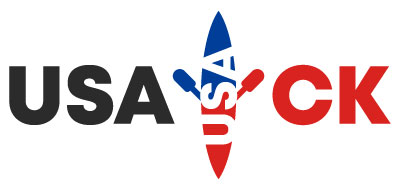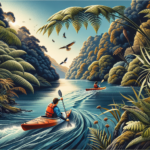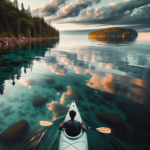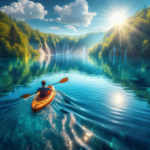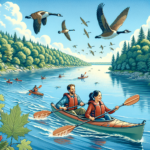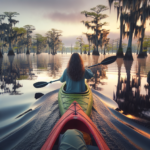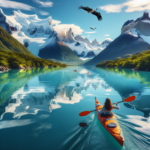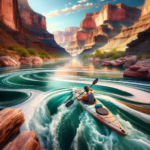Kayaking in Rhine River, Germany/Netherlands
Introduction to Kayaking
Kayaking is an exhilarating outdoor activity that has gained immense popularity worldwide. It offers a unique blend of adventure, exercise, and a close connection with nature. Whether you’re navigating through serene lakes, challenging river rapids, or exploring coastal waters, kayaking provides a thrilling experience that appeals to both beginners and seasoned paddlers. The sport’s versatility and accessibility make it a favorite among outdoor enthusiasts.
In this article, we will spotlight the unique features of kayaking in the Rhine River, which flows through Germany and the Netherlands. This iconic river offers a fantastic destination for kayaking enthusiasts, with its diverse landscapes, rich history, and vibrant culture. From tranquil stretches to more challenging sections, the Rhine River has something for everyone.
Kayaking in the Rhine River is not just about the physical activity; it’s also about immersing yourself in the natural beauty and cultural heritage of the region. The river’s scenic views, historical landmarks, and abundant wildlife make it a unique spot for kayaking experiences. Whether you’re looking for a peaceful paddle or an adventurous journey, the Rhine River has it all.
Overview of Kayaking in Rhine River, Germany/Netherlands
The Rhine River is one of Europe’s major rivers, stretching over 1,230 kilometers from the Swiss Alps to the North Sea. It flows through several countries, including Germany and the Netherlands, offering diverse kayaking opportunities. The river’s geography varies from mountainous regions to flatlands, providing a range of kayaking experiences. The climate along the Rhine River is generally temperate, with mild summers and cold winters, making it suitable for kayaking most of the year.
Historically, the Rhine River has been a vital waterway for trade and transportation, and it holds significant cultural importance in the regions it traverses. The riverbanks are dotted with charming towns, ancient castles, and vineyards, adding a historical and cultural dimension to your kayaking adventure. Visitors can access the Rhine River from various points, with well-developed infrastructure and facilities catering to tourists.
The best times to visit the Rhine River for kayaking are during the spring and summer months when the weather is pleasant, and the water levels are ideal. Autumn also offers a beautiful backdrop with the changing foliage, while winter kayaking is possible but requires more preparation and suitable gear. Regardless of the season, the Rhine River promises a memorable kayaking experience.
Kayaking Conditions in Rhine River, Germany/Netherlands
The Rhine River offers a mix of water conditions, making it suitable for different levels of kayaking expertise. The river’s upper sections, particularly in Switzerland and Germany, feature faster currents and more challenging rapids, ideal for experienced kayakers seeking an adrenaline rush. As the river flows into the Netherlands, it widens and slows down, providing calmer waters perfect for beginners and leisurely paddles.
Weather conditions along the Rhine River vary throughout the year. Spring and summer are the most popular seasons for kayaking, with temperatures ranging from 15°C to 25°C (59°F to 77°F). These months offer pleasant weather and longer daylight hours, making them ideal for extended kayaking trips. Autumn brings cooler temperatures and stunning fall foliage, while winter can be cold, with temperatures often dropping below freezing.
Tides and water currents are essential factors to consider when kayaking in the Rhine River. The river’s flow is influenced by seasonal rainfall and snowmelt from the Alps, leading to varying water levels. It’s crucial to check current conditions and forecasts before embarking on your kayaking trip. Additionally, certain sections of the river may have strong currents or obstacles, so it’s essential to be aware of your surroundings and plan your route accordingly.
Top Spots for Kayaking in Rhine River, Germany/Netherlands
The Rhine River boasts several top spots for kayaking, each offering unique features and experiences. One of the most popular sections is the Middle Rhine Valley, a UNESCO World Heritage site known for its stunning landscapes, medieval castles, and vineyards. This stretch between Bingen and Koblenz in Germany is perfect for scenic paddling and exploring historical landmarks.
Another excellent spot is the Upper Rhine, particularly around the city of Basel in Switzerland and the Black Forest region in Germany. This area offers more challenging rapids and faster currents, making it ideal for experienced kayakers seeking adventure. The picturesque surroundings and crystal-clear waters add to the appeal of this section.
In the Netherlands, the Lower Rhine provides a more relaxed kayaking experience with its wide and calm waters. The region around Arnhem and Nijmegen is particularly popular, offering beautiful natural scenery and opportunities to spot wildlife. This section is perfect for beginners and families looking for a leisurely paddle.
The best time of day for kayaking in the Rhine River is typically early morning or late afternoon when the water is calmer, and the lighting is perfect for photography. As for the best time of year, spring and summer are ideal for most sections, while autumn offers a unique experience with its vibrant colors. Winter kayaking is possible but requires more preparation and suitable gear.
Safety and Regulations
Safety is paramount when kayaking in the Rhine River, and it’s essential to adhere to local regulations and guidelines. Wearing a life jacket is mandatory, and it’s recommended to have a whistle, a waterproof map, and a first aid kit on hand. Additionally, kayakers should be aware of the river’s traffic, as the Rhine is a busy waterway with commercial vessels and recreational boats.
Before setting out, it’s crucial to check weather forecasts and water conditions. Sudden changes in weather can impact water levels and currents, so staying informed is key to a safe kayaking experience. It’s also advisable to paddle with a group or at least inform someone of your plans and expected return time.
In case of an emergency, knowing how to handle different situations is vital. Familiarize yourself with basic rescue techniques and consider taking a kayaking safety course. Local authorities and kayaking clubs often offer training sessions and resources to help you prepare for your trip.
Respecting local wildlife and natural habitats is also part of responsible kayaking. Avoid disturbing animals and plants, and follow designated routes to minimize your impact on the environment. By adhering to these guidelines, you can ensure a safe and enjoyable kayaking experience on the Rhine River.
Amenities and Accommodations
The Rhine River region is well-equipped with amenities to cater to kayaking enthusiasts. Numerous rental facilities offer kayaks, paddles, and safety gear, making it easy for visitors to access the necessary equipment. Guided tours are also available, providing valuable insights into the area’s history, culture, and natural features.
Accommodation options along the Rhine River range from camping sites to luxury hotels. For those who prefer a more rustic experience, several campgrounds are located near popular kayaking spots, offering basic facilities and a chance to immerse yourself in nature. Alternatively, charming bed and breakfasts and boutique hotels provide a comfortable stay with a touch of local hospitality.
For days when you’re not kayaking, the Rhine River region offers a variety of recreational activities. Hiking and cycling trails are abundant, allowing you to explore the scenic landscapes on foot or by bike. Wine tasting tours, cultural festivals, and historical site visits are also popular activities that provide a deeper connection to the region’s heritage.
Whether you’re looking for a budget-friendly adventure or a luxurious getaway, the Rhine River has accommodation options to suit every preference. Plan your trip in advance to secure the best deals and ensure a smooth and enjoyable experience.
Environmental Considerations
Preserving the natural habitats and wildlife of the Rhine River is crucial for maintaining its beauty and ecological balance. Eco-friendly kayaking practices are essential to minimize your impact on the environment. Avoid littering and dispose of waste properly, and use biodegradable products whenever possible.
Sticking to designated routes and avoiding sensitive areas helps protect local flora and fauna. Be mindful of your surroundings and avoid disturbing wildlife, especially during breeding seasons. By respecting nature, you contribute to the conservation efforts that keep the Rhine River pristine.
Several local projects and organizations focus on conservation and environmental protection in the Rhine River region. Supporting these initiatives through donations or volunteer work can make a significant difference. Participating in clean-up events or educational programs also helps raise awareness about the importance of preserving this natural treasure.
By adopting sustainable practices and supporting conservation efforts, you can enjoy kayaking in the Rhine River while contributing to its long-term health and beauty. Together, we can ensure that future generations can experience the same breathtaking landscapes and vibrant ecosystems.
Highlights
When comparing kayaking in the Rhine River to other popular locations, several unique features stand out. The river’s rich biodiversity, including various fish species, birds, and plant life, makes it a haven for nature lovers. The historical significance of the Rhine, with its ancient castles and cultural landmarks, adds a unique dimension to the kayaking experience.
Geographically, the Rhine River offers a diverse range of landscapes, from the mountainous regions of Switzerland and Germany to the flatlands of the Netherlands. This variety provides different kayaking challenges and scenic views, catering to all levels of paddlers. The river’s accessibility and well-developed infrastructure further enhance its appeal as a top kayaking destination.
Data-driven analysis shows that the Rhine River’s water quality and safety standards are among the highest in Europe. Regular monitoring and conservation efforts ensure that the river remains clean and safe for recreational activities. This commitment to environmental protection sets the Rhine River apart from other kayaking locations.
Overall, the Rhine River’s unique combination of natural beauty, historical significance, and excellent kayaking conditions make it a premier destination for kayaking enthusiasts. Whether you’re seeking adventure, relaxation, or cultural exploration, the Rhine River has something to offer.
FAQ Section
- What is the best season to go kayaking in the Rhine River? The best seasons are spring and summer, with pleasant weather and ideal water levels.
- Are there beginner-friendly spots for kayaking? Yes, the Lower Rhine in the Netherlands offers calm waters suitable for beginners.
- What should I bring for a kayaking trip? Essential items include a life jacket, paddle, waterproof map, first aid kit, and appropriate clothing.
- Are kayak rentals available? Yes, numerous rental facilities along the Rhine River offer kayaks and safety gear.
- How can I participate in local conservation efforts? Support local projects through donations or volunteer work, and practice eco-friendly kayaking.
- Are guided kayaking tours available? Yes, guided tours are available, providing insights into the area’s history, culture, and natural features.
- What safety measures are in place? Local regulations require life jackets, and it’s recommended to check weather forecasts and water conditions before kayaking.
Final Thoughts
Kayaking in the Rhine River, spanning Germany and the Netherlands, is a premier destination for kayaking enthusiasts. The river’s diverse landscapes, rich history, and vibrant culture offer a unique and memorable experience. Whether you’re a beginner or an experienced paddler, the Rhine River has something to offer.
Respecting local guidelines and conservation efforts is crucial to preserving the natural beauty and ecological balance of the Rhine River. By practicing eco-friendly kayaking and supporting local initiatives, you contribute to the long-term health of this iconic waterway.
In conclusion, the Rhine River’s unique combination of adventure, relaxation, and cultural exploration makes it a must-visit destination for kayaking enthusiasts. So grab your paddle, respect nature, and embark on an unforgettable journey along the Rhine River.
